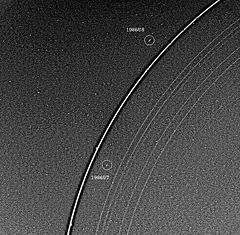- Cordelia (moon)
-
Cordelia  Discovery
DiscoveryDiscovered by Richard J. Terrile / Voyager 2 Discovery date January 20, 1986 Mean orbit radius 49751.722 ± 0.149 km[1] Eccentricity 0.00026 ± 0.000096[1] Orbital period 0.33503384 ± 0.00000058 d[1] Inclination 0.08479 ± 0.031° (to Uranus' equator)[1] Satellite of Uranus Physical characteristicsDimensions 50 × 36 × 36 km[2] Mean radius 20.1 ± 3 km[2][3][4] Surface area ~5500 km²[a] Volume ~38,900 km³[a] Mass ~4.4×1016 kg[a] Mean density ~1.3 g/cm³ (assumed)[3] Equatorial surface gravity ~0.0073 m/s²[a] Escape velocity ~0.017 km/s[a] Rotation period synchronous[2] Axial tilt zero[2] Albedo Temperature ~64 K[a] Cordelia (
 /kɔrˈdiːliə/ kor-dee-lee-ə) is the innermost moon of Uranus. It was discovered from the images taken by Voyager 2 on January 20, 1986, and was given the temporary designation S/1986 U 7.[6] It was not detected again until the Hubble Space Telescope observed it in 1997.[5][7] Cordelia takes its name from the youngest daughter of Lear in William Shakespeare's King Lear. It is also designated Uranus VI.[8]
/kɔrˈdiːliə/ kor-dee-lee-ə) is the innermost moon of Uranus. It was discovered from the images taken by Voyager 2 on January 20, 1986, and was given the temporary designation S/1986 U 7.[6] It was not detected again until the Hubble Space Telescope observed it in 1997.[5][7] Cordelia takes its name from the youngest daughter of Lear in William Shakespeare's King Lear. It is also designated Uranus VI.[8]Other than its orbit,[1] radius of 20 km[2] and geometric albedo of 0.08[5] virtually nothing is known about it. At the Voyager 2 images Cordelia appears as an elongated object, the major axis pointing towards Uranus. The ratio of axes of the Cordelia's prolate spheroid is 0.7 ± 0.2.[2]
Cordelia acts as the inner shepherd satellite for Uranus' Epsilon ring.[9] Cordelia's orbit is within Uranus' synchronous orbit radius, and is therefore slowly decaying due to tidal deceleration.[2]
See also
References
Explanatory notes
Citations
- ^ a b c d e Jacobson, R. A. (1998). "The Orbits of the Inner Uranian Satellites From Hubble Space Telescope and Voyager 2 Observations". The Astronomical Journal 115 (3): 1195–1199. Bibcode 1998AJ....115.1195J. doi:10.1086/300263.
- ^ a b c d e f g Karkoschka, Erich (2001). "Voyager's Eleventh Discovery of a Satellite of Uranus and Photometry and the First Size Measurements of Nine Satellites". Icarus 151 (1): 69–77. Bibcode 2001Icar..151...69K. doi:10.1006/icar.2001.6597.
- ^ a b c "Planetary Satellite Physical Parameters". JPL (Solar System Dynamics). 24 October 2008. http://ssd.jpl.nasa.gov/?sat_phys_par. Retrieved 12 December 2008.
- ^ a b Williams, Dr. David R. (23 November 2007). "Uranian Satellite Fact Sheet". NASA (National Space Science Data Center). http://nssdc.gsfc.nasa.gov/planetary/factsheet/uraniansatfact.html. Retrieved 12 December 2008.
- ^ a b c Karkoschka, Erich (2001). "Comprehensive Photometry of the Rings and 16 Satellites of Uranus with the Hubble Space Telescope". Icarus 151 (1): 51–68. Bibcode 2001Icar..151...51K. doi:10.1006/icar.2001.6596.
- ^ Smith, B. A. (1986-01-27). "Satellites and Rings of Uranus". IAU Circular 4168. http://www.cbat.eps.harvard.edu/iauc/04100/04168.html#item1. Retrieved 2011-10-31.
- ^ Showalter, M. R.; Lissauer, J. J. (2003-09-03). "Satellites of Uranus". IAU Circular 8194. http://www.cbat.eps.harvard.edu/iauc/08100/08194.html. Retrieved 2011-10-31.
- ^ "Planet and Satellite Names and Discoverers". Gazetteer of Planetary Nomenclature. USGS Astrogeology. July 21, 2006. http://planetarynames.wr.usgs.gov/append7.html. Retrieved 6 August 2006.
- ^ Esposito, L. W. (2002). "Planetary rings". Reports On Progress In Physics 65 (12): 1741–1783. Bibcode 2002RPPh...65.1741E. doi:10.1088/0034-4885/65/12/201.
External links
Uranus Discovery 
Characteristics - Atmosphere
- Climate (Uranus Dark Spot)
- Magnetosphere
- Rings
- Moons
Major moons Exploration - Voyager program (Voyager 2)
- Uranus orbiter and probe (proposed)
Miscellaneous - 15 Orionis
- Uranus-crossing minor planets
- Uranus in fiction
Moons of Uranus Generally listed in increasing distance from Uranus Inner Major (spheroid) Outer (irregular) Geological features - Arielian
- (Kachina Chasma
- Yangoor)
- Mirandian
- (Verona Rupes)
- Oberonian
- (Hamlet
- Mommur Chasma)
- Puckian
- Titanian
- (Gertrude
- Messina Chasma
- Ursula
- Rousillon Rupes)
- Umbrielian
- (Wunda
- Vuver
- Skynd)
Categories:- Moons of Uranus
- Astronomical objects discovered in 1986
Wikimedia Foundation. 2010.
